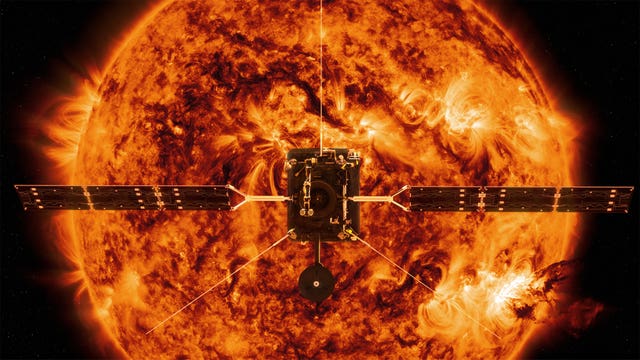Lift off: Solar Orbiter on its way to the Sun
The shuttle carrying the satellite launched into space in the early hours of Monday morning.

The Solar Orbiter – which aims to unlock the secrets of the Sun – is on its way to the star.
Built by Airbus in Stevenage, it lifted off into space in the Atlas V 411 rocket from Nasa’s Cape Canaveral site in Florida just after 4am UK time.
There were hugs of congratulations and relief at the European Space Agency’s (ESA) European Space Operations Centre at the successful launch.
While in Florida, Gunther Hasinger, ESA’s director of science, and Thomas Zurbuchen, NASA’s associate administrator for the science mission directorate, gave a thumbs up, declaring: “We have a mission.”
Signals from the spacecraft were received at New Norcia Station ground station at 5am, following separation from the launcher upper stage in low Earth orbit.
Prof Hasinger said: “As humans, we have always been familiar with the importance of the Sun to life on Earth, observing it and investigating how it works in detail, but we have also long known it has the potential to disrupt everyday life should we be in the firing line of a powerful solar storm.”

Cesar Garcia Marirrodriga, ESA’s Solar Orbiter project manager, added: “After some twenty years since inception, six years of construction, and more than a year of testing, together with our industrial partners we have established new high-temperature technologies and completed the challenge of building a spacecraft that is ready to face the Sun and study it up close.”
The satellite will orbit the star, beaming back high-resolution photos and measuring the solar wind as part of the mission led by the European Space Agency (ESA) and partly funded by the The UK Space Agency.
It will take about two years to reach the Sun, which scientists call the “cruising phase”.
Coated with a heat shield, called SolarBlack, the spacecraft can endure temperatures of more than 500C, hot enough to melt lead.
The satellite will make a close approach to the sun every five months, and at its closest will only be 26 million miles away, closer than the planet Mercury.
At these times it will be positioned over roughly the same region of the Sun’s surface for several days, as the Sun rotates on its axis.

This will allow the spacecraft to observe magnetic activity building up in the atmosphere that can lead to powerful flares and eruptions, providing new insights into the giant storms raging on its surface.
Predicting when these storms occur could help governments and companies protect these satellites and other communications infrastructure.
Mark McCaughrean, senior adviser for science and exploration at the ESA, said the satellite will be in full science operations mode by November 2021, which is when it will be in the right orbit.
Explaining why the mission is important, he told the PA news agency: “From a scientific perspective it is about the mystery of this big object sitting at the centre of our solar system.
“It is about understanding that big monster that sits at the centre of our solar system better.”
Prof McCaughrean said that when the shuttle launched the room was silent, as everyone knew the danger would not pass until 57 minutes later.
But at about 6.30am they opened a “cheap bottle of plonk” to celebrate.





